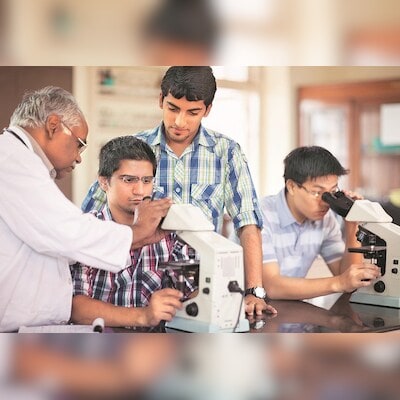Union Budget 2024-25 emphasises the government’s commitment to ‘Viksit Bharat, or developed India. One highlight is the focus on seamlessly bridging industry and employment linkages through three schemes for ‘employment linked incentive’ under the Prime Minister’s package.
The substantially increased budgetary allocations for PM-Ayushman Bharat Health Infrastructure Mission, Pradhan Mantri Jan Arogya Yojana, and programmes for mental health will bolster improvements in health care. The Budget also amplifies initiatives like PM Vishwakarma, PM SVANidhi, National Livelihood Missions, and Stand-Up India, empowering craftsmen, artisans, self-help groups, SC/ST and women entrepreneurs, and street vendors, which will create jobs and boost local economies.
Overall, this budget “encompasses all”.
Education
The Budget emphasises enhancing educational and employment opportunities for youth through new schemes. Interest subvention for education loans for 100,000 students annually is expected to expand access to quality education. The new internship scheme offering opportunities to 10 million students in 500 top companies and increase in outlay for industry apprenticeship (30 per cen) are commendable steps towards producing industry-ready graduates. Flagship schemes aimed at enhancing infrastructure, teaching-learning resources, and nutritional support have received substantial boosts with Samagra Shiksha Abhiyan, PM-POSHAN and PM-SHRI receiving budget increase by Rs 4,010 crore, Rs 2,467 crore and Rs 3,250 crore respectively.
However, the reduction in the University Grants Commission (UGC) allocation from Rs 6,400 crore to Rs 2,500 crore may challenge public universities’ funding. The Budget increases by 33 per cent allocation for the teacher training mission, 69 per cent to Rs 355 crore for research funds, and 21 per cent for digital learning initiatives.
Public health, nutrition
The Union Budget notes a 13 per cent increase in health allocation from last year, reflecting the government’s continued commitment to strengthening health care. PM-Ayushman Bharat Health Infrastructure Mission, has witnessed a 178 per cent increase in allocation from last year under central schemes, reflecting sustained focus on bolstering health systems including future preparedness. In line with the latest economic survey, mental health gained attention in the budget with over 33 per cent allocation for different initiatives including those under tertiary care programme. The allocation for health research has experienced a positive trend with a 14 per cent increase. Despite a 34 per cent dip in health research funding for One Health, the Budget redirects focus with an 88 per cent increase in establishment and strengthening of National Center for Disease Control (NCDC) and its initiatives. The PMJAY which has been instrumental in enhancing health coverage and positively affecting loan performance, saw a modest 7 per cent increase. Though the Economic Survey calls to action for climate related health events, the budget does not explicitly address it, however, the upcoming taxonomy of climate finance might pave way for focused attention.
)
Social enterprise, livelihood
The outlay for MGNREGS in FY25 Budget estimate remains same as revised in the interim Budget to Rs 86,000 crores for FY24. There was a significant upward revision of the rural employment allocation budget in the interim budget, from the original Budget estimate of Rs 60,000 crores. Observations from the economic survey FY23-24 suggest that the average person-days per household has improved by 9 per cent in comparison to last year after mild dipping trends in the last two consecutive fiscal years. The underlying assumption that poorer states with high unemployment rates are utilizing MGNREGS better is challenged by the actual scenario where the richer states with low share of the poor have a relatively higher utilisation of MGNREGS funds.
)
Employment, skill development
The government’s strategic vision for employment and skill-driven prosperity is showcased through initiatives aimed at increasing industry involvement, forging state partnerships, and supporting the aspirations of 20 lakh youth with a new centrally sponsored skill development scheme. Additionally, three schemes focused on ‘Employment Linked Incentives,’ including one month wage for new entrants, incentives for EPFO contributions, and employer support, will enhance opportunities for youth. These comprehensive skilling efforts, which encompass model skill loans, upgradation of 1,000 Industrial Technical Institutes (ITIs), course content alignment, and capacity expansion of training institutes, will significantly boost youth participation in the workforce.
In terms of total budget allocation, there is an increased provisioning of Rs 55% for Skill India programme comprising of three schemes namely, Pradhan Mantri Kaushal Vikas Yojana 4.0 (PMKVY. 4.0), Pradhan Mantri- National Apprenticeship Promotion Scheme (PM-NAPS) and Jan Shikshan Sansthan (JSS).
)
Gender
We commend the Government’s dedication to enhancing women’s roles in economic development. Initiatives such as setting up working women hostels, establishing creches, and implementing women-centric skilling programs in partnership with industry are vital steps to increase women’s workforce participation and promote gender equality. With an allocation exceeding Rs 3 trillion for schemes benefiting women and girls, we believe this will lead to comprehensive, widespread, and inclusive development for women.
By Anjan Chakraborty, Partner – Social Sector, PwC India
First Published: Jul 25 2024 | 6:20 AM IST
